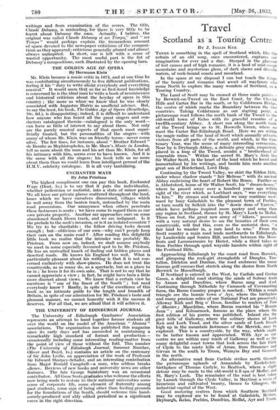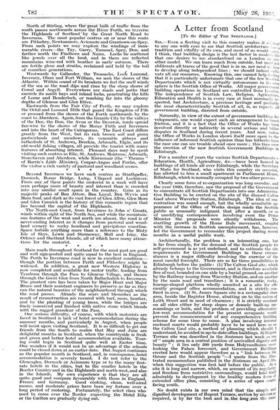Travel
Scotland as a Touring Centre
By J. INGLIS KER.
THERE is something in the spell of Scotland which, like the refrain of an old song, once encountered, captures our
imagination for ever and a day. Steeped in the glamour. of lost causes and of high romance, it is a. land of mist-swept mountains and mysterious glens, of dark shaws and drunilie waters, of rock-bound coasts and moorland. _ _ In the space at my disposal I can but touch the fringe of the beauty and romance that await all wayfarers who come North to explore, the many wonders of Scotland, as a Touring Country.
The Land of Scott may be crossed at three main points— by Berwick-on-Tweed on the East Coast, by the Cheviot
Hills and Carter Bar in the south, or by Coldstream Bridge, the centre of which marks the Boundary between the two countries. Taking Coldstream _as our starting point,
picturesque road follows the north hank of the Tweed to the old-world town of Kelso with its graceful remains of a twelfth-century Abbey. A short run along the north bank of the Tweed brings us to St. Boswells Green, where we meet the Carter Bar-Edinburgh Road. Here we are within the magic radius of the land of Scott which annually attracts visitors from all parts of the world, and which, in the Cen- tenary Year, was the scene of many interesting ceremonies.
Near by is Dryburgh Abbey, a delicate grey ruin, exquisitely placed in a loop of the Tweed, amidst a ` brotherhood of venerable trees." Within the sacred St. Mary's Aisle lies Sir Walter Scott, in the heart of the land which he loved and immortalized by his writings, ..and beside him rests another great son of Borderland, Lord Haig.
Continuing by the Tweed Valley, we skirt the Eildon
under whose shadow stands " fair Melrose " with its ancient Abbey enshrining the heart of Robert the Bruce. Farther on
is Abbotsford, home of Sir Walter Scott, his " dream-house,"
where he passed away over a hundred years ago within sight of the river which, as Lockhart says, was everything
to him." By stream and woodland we may continue west- ward by busy Galashiels to the pleasant town of Peebles, or turn south by Selkirk into the dowie dens of Yarrow," which have perhaps inspired more poetry and song than any region in Scotland, thence by St. Mary's Loch to Moffat. Those on foot, the great new army of " hikers," possessed
with a very natural desire to see the beauties of their own
countryside, will find this, even as the motorist does, " a fair land to wander in, a rare land to woo." From the Scott country a main road leads northwards to Edinburgh, by Lauderdale apd Soutra Hill, another between the Moor- foots and Lafmnermuirs by Heriot, while a third takes us from Peebles through quiet wayside hamlets within sight of the Pentland Hills.
Approaching Edinburgh by the coast road from Berwick, and glimpsing the rock-girt strongholds of Dunglas, Tan-' talon, Dirleton and Dunbar, the road embraces the many famous golf courses that stretch along the shores from North Berwick to Musselburgh.
If Scotland is entered in the West, by Carlisle and Gretna ! Green; a delightful road- skirting the sands of Solway leads by Annan and Dumfries, where Burns sang and d:ed.
Continuing through Nithsdale by • Cumnock of Covenanting
fame,- the Burns Country proper is reached... Within-a rough. triangle are the bonnie town o' Ayr, where the birthplace ! and many precious relics of our National Poet are preserved ; Alloway Kirk and Brig Doon; familiar to readers of Tani o' Shanter-; ..Maucitline, -where Burns married his " Bonnie
Jean " ; and Kilmarnock, fanious as the place where the first edition of his poems was published. Inland rise the grey hills of Galloway, where the solitary 'shores of Loch Ken and Loch Trool, and the silver sands of Loch Enoch high up in the mountain fastnesses of the Merrick, may he explored. This 'is a countryside, by the way, which ought to be better known .and appreciated. With Ayr as our centre we are within easy reach of Galloway as well as the many delightful coast towns that look across the fair Firth of Clyde to the misty hills of Arran, from Stranraer and Girvan in the south to Troon, VVemyks Bay and Gourock in the north.
An alternative road from Carlisle strikes north through the picturesque uplands of Annandale by Ecclefechan, birthplace of Thomas Carlyle, to Beattock, where a slight detour may be made to the old-world• h.11 spa of Moffat, and St. Mary's Loch. The remainder of the road isc best taken by Lanark through the Clyde Valley, in Maytinie a scene of luxurious and cultivated beauty, thence to GlasgOw, the industrial capital of the West. Good motoring centres from which Southern Scotland may be explored- are to be found at Galishiels; 'Melrose, Dryburgh, Kelso. Peebles, Dumfries, Moffat, Ayr And Troop. North of Stirling, where thetreat b-filk of traffic from the south passes northwards across the Riirer Forth, we traverse the Highlands of Scotland' by the Great North Road to Inverness. The most popular centres on or near this route are Pitlochry, Newtonmore, Aviemoke and Grantown-on-Spey. From such points we may explore the windings of innu- merable rivers—the Tay, Garry, Tummel, Spey, Don, and farther north the Findhorn and Nairn. Lochs lie scattered like jewels over all the land, and in them are reflected mountains wine-red with heather in early autumn. There are fertile glens and straths, reclaimed and held by the toil of countless generations.
Westwards by Callander, the Trossachs, toefi Lomond, Inverary, Oban and Fort William, we seek the shores of the Atlantic. Within sound of its breakers we feel the snell winds of the sea as the road dips and rises by the steep shores of Cowal and Argyll. Everywhere are roads and paths that encircle its sunlit bays and inland lochs, penetrating the hills of Lorne and Benderloch, or reaching far into the gloomy depths of Glencoe and Glen Etive.
Eastwards from the Fair City of Perth, we may explore the Ochil and Lomond Hills that guard the Kingdom of Fife or proceed from -the shores -of the Forth northwards by the coast to Aberdeen. Again, from the Granite City by the valleys of the Dee, the Don, the Avon or the Deveron, roads spread fan-wise to the shores of the Moray Firth and Inverness and into the heart of the Cairngorms. The East Coast differs greatly from the West, but its rich brown soil and green pasturelands and meadows, its venerable abbeys and cathedrals of St. Andrews, Brechin, Arbroath, Elgin, and- its old-world fishing villages, all provide the tourist with many features of absorbing interest. Pleasant days may be spent visiting such centres as Elie, St. Andrews, Montrose, Arbroath, Stonehaven and Aberdeen, while Kirriemuir (the " Thrums " of Barrie's Little Minister), Coupar-Angus and Forfar, offer the visitor a rich variety of pastoral and woodland scenes.
* * * * Beyond Inverness we have such centres as Strathpeffer, Dornoch, Bonar Bridge, Lairg, Ullapool and Loehinver. From any ,of these _points the motorist in a week will have seen perhaps more of beauty and interest than is crowded into any similar small space in the country. Grim as its majestic peaks of. Ben Attow, Ben _ Loyal, Ben . Wyvis and Main Soul, and dark as its vast forest of Glen Affric, Glen More and Glen Cannich is the history of this romantic region that lies beyond the capital of the Highlands.
The North-east Coast, from Inverness to John o' Groats, winds within sight of the North Sea, and while the mountain- ous features of the west and north are absent, the road is of never-ending interest as it changes from pastoral and wood- land scenery to rocky headland and precipitous coastline. Space forbids anything more than a reference to the Misty Isle of Skye, Lewis and Stornoway, Mull and Islay, the Orkney and Shetland Islands, all of Which have many attrac- tions for the motorist.
* * * *
Main roads throughout Scotland for the most part are good and well sign-posted and quite equal to the best in England. The Perth to Inverness road is now in excellent condition— though the portion between Perth and Pitlochry might be widened. In addition, a great new Western Highway is now completed and available for motor traffic, leading from Tyndrum through the Pass to Glencoe Village, and thence through the Great Glen from North Ballachulish to Inverness. The greatest care has been taken by Major Hunt and Major Bruce and their assistant engineers to preserve as far as they can the natural beauties of the neighbourhood through which the road passes. Already_ the scars and blemishes as the result of reconstruction are covered with turf, moss, heather, and by the planting of young trees, while the bridges Are finely conceived and finished with native stone which blends with the rugged grandeur of. the Pass, One serious difficulty, of course, with which motorists are faced in. Scotland is lack of hotel accommodation during the summer months, and particularly in August, when people will insist upon visiting Scotland.. It is so difficult to get our friends from the South to realise that May and June are delightful months in Scotland, when the countryside is fresh and green and better hotel accommodation available. Tour- ing could begin in Scotland quite well at Easter time. One wonders if it would not be an advantage if the schools could be closed down at an earlier date. But August continues as the popular month in Scotland, and, in consequence, hotel accommodation is severely taxed. I do not refer to the Gleneagles, Dornoch or Aviemore type or to the many' first- rate hotels in the cities, but to the smaller hotels in the Border Country and in the Highlands and north-west, and also in the Islands. My own experience is that they are all quite good and compare favourably with those in England, France and Germany. Good cooking, clean, well-aired rooms, and moderate prices have been my fortune over a long period of motoring. Fortunately, the select class who used to come over the Border expecting the Hotel Ritz or the Carlton are gradually dying out.

















































 Previous page
Previous page